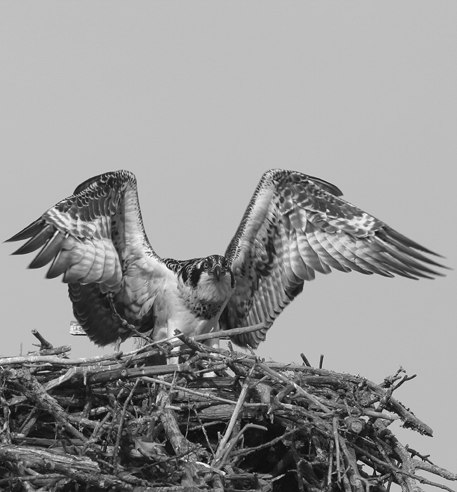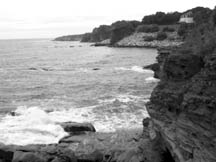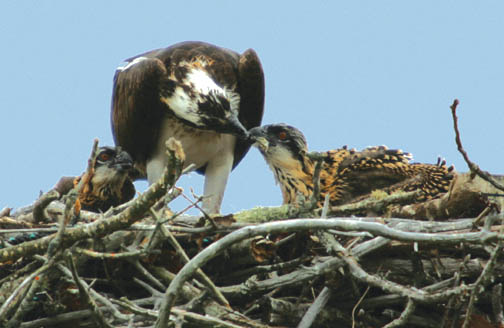
|
An
Osprey Tribute
But six weeks later: a round, pinkish eggósurely that was a good sign? And a second, seven days later! Don't get your hopes up, we were told; they are just too late. Nature can be like that. Young ospreys are not always successful in their first attempt at starting a family. But our female, likely a first-time mother, heard none of it. She was diligent, patient. Remember the cold and rainy spring of 2003? She sat nobly on a modest nest of twigs and moss and dried eelgrass, rearranging it again and again and again. It rained. Would it ever stop raining? And the winds blew from every direction. And then summer arrived.
The sun beat down, mercilessly. Extreme weather. We felt her discomfort;
shared her anxiety. The first egg hatched that afternoon. An awkward, matted osprey emerged. We rejoiced, as if we had given birth. Five days later we spotted osprey number two, and we cele-brated again. Demanding young chicks: these ospreys wanted fish, fish, fish. Dad wasn't catching enough, and mom cried out to him over on his perch. More! The chicks flopped around the nest; we worried they weren't getting enough to eat. One was so much bigger than Two. Will Two make it? Within a few days, mom was leaving the nest for short periodsósometimes joining dad on the tower, sometimes stretching her wings and circling overhead, occasionally fishing. Back at the nest, prize in talons, she would rip off small pieces of flesh and place them into open beaks. We watched as their down fluff became feather-like. We witnessed nature's ingenuity: the camouflage stripe that developed on their backs, disguising the chicks as sticks in the nest, fooling predators flying overhead.
The chicks at seven weeks displayed the necklace pattern of breast feathers; we think they are females. They stretch their new-feather wings and nest-fly, flapping, flapping, as nest-mates cower. We admired their newly found courage: furtive glimpses from nest-edge, seeking a view of what lay beyondÖand below. Imitating mom with nonchalant gazes from the perchóonly the death-grip of talons on wood betraying their anxiety. And when theflapping was robust enough, they would levitate over the nest, talons out, as if preparing for a crash-landing.
But Two would fly the following week as One called out loudly in encouragement. Mom didn't watch at first. Had she a mother's instinct that the first flight of Two would be so clumsy? Did her heart stop with ours as Two disappeared behind the bushes? Resume beating as Two reappeared, banking hard, as if just then remembering the part about flapping her wings? The landing was awkward too, but three in a nest is a tough test, even for mom. They are fishing on their own now, and we know that they will be leaving soon. One and Two will spend the next year and a half down south, before returning to the area to start their own families. It is nearly fall. The rain is back; the air crisp. We look anxiously to the nest each morning. Any day could be the day we find it empty. Our hearts will be heavy then, for these ospreys filled our summer with their antics and preening, nest-arranging and chatter. The daily catches, majestic flights. They gave us the chance to witness the wonder of nature for what it is and not what it might have been. Our ospreys beat the
odds.
Author's Note: We
watched our ospreys from the Woods Hole Sea Grant office windows,
and shared them with the community via a webcam set up by WHOI.
Look for them next year at http://128.128.32.108/view/view.shtml.
Thanks to Rick Galat, Matt Barton, and everyone who rooted for them
during the spring and summer of 2003! |


